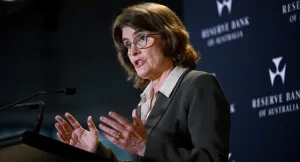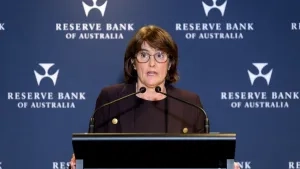Under governor Michele Bullock, the Reserve Bank not only looks increasingly confused in its explanations for why it has refused to cut interest rates in response to falling inflation, but now institutional pride and defensiveness are also creeping in.
There was a telling moment last week when Bullock gave a speech in Sydney and fielded questions afterwards. The governor was asked if the RBAs monetary policy board would have cut rates in early July if it had had access to the June jobs report. That was the report showing a jolt in unemployment caused by employers cutting back on hours worked.
I dont believe so, Bullock replied, adding that she wouldnt overinterpret every single number.
That was a remarkable and, with all due respect to the governor, unbelievable answer.
Remarkable because the monetary policy board statement after the July meeting literally said the RBA was waiting for a little more information before determining when to start easing rates. Given the hypothetical that she was given a little more information, Bullock insisted theyd made the right decision anyway.
One persons a little more information is anothers overinterpreting every single number, evidently.
Related Article Block Placeholder Article ID: 1176408

Thats defensiveness and pride creeping in. Bullock is no more resistant to them than the rest of us. Its also absurd to believe the board wouldnt have cut rates knowing that the labour market was showing signs of significantly easing in June.
This reliance on a little more information as an excuse for inaction is self-defeating and shows a lack of leadership, which seems to be the defining characteristic of Bullocks time as governor. The RBA must always partly be flying blind, given the lag of economic data one of the reasons it invests a lot of money in liaison with thousands of businesses.
And theres always more data. The next board meeting on August 11-12 will be held the day before the Australian Bureau of Statistics releases the important wage price index for the June quarter and 2024-25, which will provide a key insight into the labour market and inflation pressures. The following day, August 14, the ABS will release July labour force data, along with a second, less useful wage measure: average weekly earnings.
The ABS doesnt just randomly release this stuff; the release calendar revolves around a quarterly and monthly cycle. If the RBA is so animated about the need for a little more information, its easily improved by timing monetary policy board meetings after the release of important information especially quarterly data. But that would necessitate the RBA being serious about not having enough data, rather than just looking to justify its bad decisions.
In her Sydney speech, Bullock gave another indicator she just might not be up for this job, doubling down on the RBAs new mantra its third mandate, if you like of being measured and gradual. But in this emphasis on gradual, Bullock has replaced the ends with the means. Focusing on being gradual substitutes the goal of full employment and inflation within the target band for how to achieve those.
Making gradual the policy goal of the RBA makes no sense anyway: monetary polices already move gradually through the economy, unless theyre large, sudden crises that shock the community positively or negatively. Only a third of the workforce has a mortgage, and a majority of mortgage holders dont cut their repayments with each rate cut anyway. The other two-thirds either rent or own their own homes, and the policy transmission passes them by unless theyre about to buy a dwelling.
Insisting that monetary policy be gradual is like saying steering a cruise ship should always be gradual. Youre committing to a policy of making a slow change even slower.
Related Article Block Placeholder Article ID: 1214708

We know where gradual got us in the 2010s workers endured years of wage stagnation and higher than necessary unemployment because the RBA under Glenn Stevens and Philip Lowe failed to cut interest rates for years at a time, despite inflation being below the target band.
Unemployment is higher than it needs to be because of the RBAs repeated mistakes, first in lifting rates in late 2023 and then in failing to cut rates faster from late 2024. Gradual is killing jobs and businesses out in the real world every day.
Bullock tried to spin the June jobs data as being in line with the RBAs May forecasts and on its own suggests the labor market moved a little further towards balance, as we were anticipating. But the RBA had not expected the 4.3% rate to be hit until the end of 2025.
Its a lot like the ship captain declaring that the large island dead ahead is right where she expects it to be, and that there is no need for any rush to steer the ship away. The more often she says it and the louder she says it, the more you begin to wonder whether someone else ought to be in charge instead.



